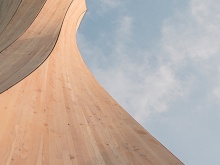Active Wood Morphology
ICD/ITKE Research Pavilion 2021/22
Wood is a performative, sustainable, and structural material widely used in architecture across cultures. Moreover, as a result of its anisotropic fibrous cellular structure wood as a material possess intrinsic active properties giving it the ability to change shape and stiffness in response to moisture. These hygroscopic forces cause shrinking and swelling typically resulting in uncontrolled and unwanted deformations. However, when employed in a designed approach such natural forces can be utilized as a highly effective generator of physical form. The focus of this studio is the investigation and deployment of self-shaping wood material systems for in situ, autonomous construction and the related architectural morphologies. The overarching aim is to employ the powerful shaping behaviors of wood as an alternative to large machines shaping and assembling components on the construction site. Students will work in teams, in close collaboration with academic staff to rigorously design, model and test concepts through physical fabrication and simulation. The studio offers the opportunity to apply computational design in a design concept for a abuilding demonstrator accompanied by an underlying methodology and functioning full scale prototypes. On a technical level, the studio will investigate wood material systems for self-construction and self-assembly as well as the associated methods of robotic prefabrication, material digitization, and additive material informed fabrication. In parallel students will incorporate the transfer of movement principles discovered through biomimetic investigations of self-shaping mechanisms in an adjacent seminar. Computational design will serve as a basis for furthering development of integrative modeling approaches for both the analysis and exploration of new architectural morphologies of self-shaping. Systems will be evaluated based on levels of autonomy, as well as structural, architectural and ecological performance. Particular attention will be directed towards the ecological aspects of the building materials and construction processes by developing an approach considering the potentials for integrating active materials behaviors in an architecture that is not only bio-inspired, but bio-based and uniquely bio constructed.
Requirements include: Participation in the design integrated seminars - Computational Design Techniques and Design Thinking, and Form and Structure. Highly recommended participation in the seminar Architectural Biomimetics.
ICD/ITKE Research Pavilion 2021/22
Wood is a performative, sustainable, and structural material widely used in architecture across cultures. Moreover, as a result of its anisotropic fibrous cellular structure wood as a material possess intrinsic active properties giving it the ability to change shape and stiffness in response to moisture. These hygroscopic forces cause shrinking and swelling typically resulting in uncontrolled and unwanted deformations. However, when employed in a designed approach such natural forces can be utilized as a highly effective generator of physical form. The focus of this studio is the investigation and deployment of self-shaping wood material systems for in situ, autonomous construction and the related architectural morphologies. The overarching aim is to employ the powerful shaping behaviors of wood as an alternative to large machines shaping and assembling components on the construction site. Students will work in teams, in close collaboration with academic staff to rigorously design, model and test concepts through physical fabrication and simulation. The studio offers the opportunity to apply computational design in a design concept for a abuilding demonstrator accompanied by an underlying methodology and functioning full scale prototypes. On a technical level, the studio will investigate wood material systems for self-construction and self-assembly as well as the associated methods of robotic prefabrication, material digitization, and additive material informed fabrication. In parallel students will incorporate the transfer of movement principles discovered through biomimetic investigations of self-shaping mechanisms in an adjacent seminar. Computational design will serve as a basis for furthering development of integrative modeling approaches for both the analysis and exploration of new architectural morphologies of self-shaping. Systems will be evaluated based on levels of autonomy, as well as structural, architectural and ecological performance. Particular attention will be directed towards the ecological aspects of the building materials and construction processes by developing an approach considering the potentials for integrating active materials behaviors in an architecture that is not only bio-inspired, but bio-based and uniquely bio constructed.
Requirements include: Participation in the design integrated seminars - Computational Design Techniques and Design Thinking, and Form and Structure. Highly recommended participation in the seminar Architectural Biomimetics.


